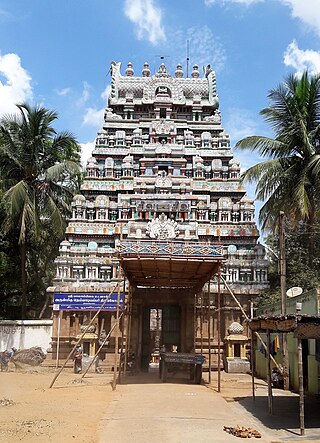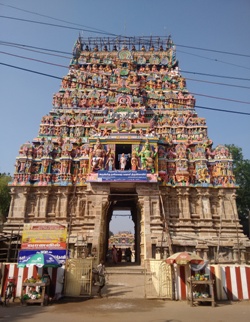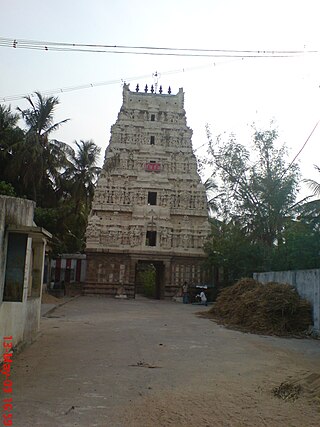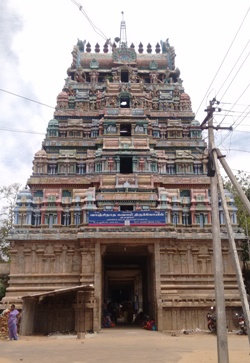
Neyyadiappar Temple, Tillaistanam is a Hindu temple dedicated to Shiva located in the village of Thillaisthanam also known as Tillaisthanam or Thiruneithanam in Tamil Nadu, India. It is significant to the Hindu sect of Shaivism as one of the Saptasthanam, the seven temples associated with Aiyarappar temple in Thiruvaiyaru. Shiva is represented by the lingam in the form of Neyyadiappar. His consort Parvati is depicted as Piraisoodi Amman. The presiding deity is revered in the 7th century Tamil Shaiva canonical work, the Tevaram, written by Tamil saint poets known as the nayanars and classified as Paadal Petra Sthalam.

Kandeeswarar Temple is a Hindu temple dedicated to the god Shiva located in Kandiyur also known as Thirukkandiyur or Tirukkandiyur, near Tiruvaiyaru, Tamil Nadu, India. Shiva is worshiped as Kandeeswarar, and is represented by the lingam and his consort Parvati is depicted as Mangalanayagi. The presiding deity is revered in the 7th century Tamil Saiva canonical work, the Tevaram, written by Tamil poet saints known as the nayanars and classified as Paadal Petra Sthalam. As per legends, Shiva is believed to have destroyed eight different demons and the eight Ashta Veeratanam temples are built signifying each of his victories in the war. The temple is one of the eight where Shiva is believed to have removed one of the five heads of Brahma.

Aiyarappar is a Hindu temple dedicated to Shiva located in the village of Tiruvaiyaru, Tamil Nadu, India. Shiva is worshiped as Aiyarappar, and is represented by the lingam and his consort Parvati is depicted as AramValarthaNaayagi. The presiding deity is revered in the 7th century Tamil Saiva canonical work, the Tevaram, written by Tamil poet saints known as the nayanars and classified as Paadal Petra Sthalam.

Nageswaraswamy Temple, Kumbakonam is a Hindu temple dedicated to Shiva located in Kumbakonam in Thanjavur district, Tamil Nadu, India. The presiding deity is revered in the 7th-century Tamil Saiva canonical work, the Tevaram, written by Tamil poet saints known as the nayanars and classified as Paadal Petra Sthalam. The temple is counted as the earliest of all Chola temples. Shiva in the guise of Nagaraja, the serpent king..

Tirunageswaram Naganathar Temple also known as Rahu Stalam is a Hindu temple dedicated to the deity Shiva, located in Tirunageswaram, a village in the outskirts of Kumbakonam, a town in Tamil Nadu, India. It is significant to the Hindu sect of Saivism as one of the temples associated with the nine planet elements, the Navagraha Stalas, and specifically Rahu. Shiva is worshiped as Naganathar, and is represented by the lingam. His consort Parvati is depicted as Piraisoodi Amman. The presiding deity is revered in the 7th century Tamil Saiva canonical work, the Tevaram, written by Tamil saint poets known as the nayanars and classified as Paadal Petra Sthalam.

Anbil Alanthurai Temple is a temple dedicated to Shiva, located on the banks of the Kollidam river in Anbil, a small village near Lalgudi. is a Hindu temple dedicated to Shiva located in the village of Tiruchotruthurai, Tamil Nadu, India. Shiva is worshiped as Sathyavaheeswarar, and is represented by the lingam and his consort Parvati is depicted as Soundaranayagi. The presiding deity is revered in the 7th century Tamil Saiva canonical work, the Tevaram, written by Tamil poet saints known as the nayanars and classified as Paadal Petra Sthalam.

Sivayoginathar Temple also known as Yoganandeswarar temple is a Hindu temple dedicated to Shiva located in is located in Thiruvisanallur in Thanjavur district, Tamil Nadu, India. Shiva is worshiped as Sivayoginathar, and is represented by the lingam and his consort Parvati is depicted as Mangala Nayagi. The presiding deity is revered in the 7th century Tamil Saiva canonical work, the Tevaram, written by Tamil poet saints known as the nayanars and classified as Paadal Petra Sthalam.

Vanchinadha Swamy temple is a Hindu temple dedicated to the deity Shiva, located in Srivanchiyam, Tiruvarur District, Tamil Nadu, India. Shiva is worshiped as Vanchinadha Swamy, and is represented by the lingam. His consort Parvati is depicted as Mangalambigai Amman. The presiding deity is revered in the 7th century Tamil Saiva canonical work, the Tevaram, written by Tamil saint poets known as the Nayanmars and classified as Paadal Petra Sthalam.

Prananadeswarar Temple is a Hindu temple dedicated to Shiva located in Thirumangalakudi in Mayiladuthurai district of Tamil Nadu, India. Shiva is worshiped as Prananatheswarar, and is represented by the lingam and his consort Parvati is depicted as Mangala Nayagi. The presiding deity is revered in the 7th century Tamil Saiva canonical work, the Tevaram, written by Tamil poet saints known as the nayanars and classified as Paadal Petra Sthalam.

Pushpavananathar Temple is a Hindu temple dedicated to Shiva located in the village of Tiruppoonturutti near Tiruvaiyaru, Tamil Nadu, India. Shiva is worshiped as Aiyarappar, and is represented by the lingam and his consort Parvati is depicted as Soundaranayagi. The presiding deity is revered in the 7th century Tamil Saiva canonical work, the Tevaram, written by Tamil poet saints known as the nayanars and classified as Paadal Petra Sthalam.

Vedapuriswarar Temple, Thiruvedhikudi or Vazhaimadunathar Temple is a Hindu temple dedicated to Shiva located in Thiruvedhikudi near Tiruvaiyaru, Tamil Nadu, India. The presiding deity is revered in the 7th century Tamil Saiva canonical work, the Tevaram, written by Tamil poet saints known as the nayanars and classified as Paadal Petra Sthalam. The temple is counted as the earliest of all Chola temples.

Apathsahayar Temple, Thirupazhanam is a Hindu temple dedicated to Shiva located in Thirupazhanam near Tiruvaiyaru, Tamil Nadu, India. The presiding deity is revered in the 7th century Tamil Saiva canonical work, the Tevaram, written by Tamil poet saints known as the nayanars and classified as Paadal Petra Sthalam. The temple is counted as the earliest of all Chola temples.

Tirunallar Saniswaran Temple or Dharbaranyeswarar Temple is a Hindu temple dedicated to the deity Shiva, located in a village, Thirunallar of karaikal district of Union territory of Puducherry (24 km from Nagapattinam town of Tamil Nadu.

Pasupatheeswarar Temple, Avoor or Avoor Pasupatheeswaram is a Hindu temple dedicated to Hindu god Shiva, located in the village Avoor, located 12 km south of South Indian town, Kumbakonam, Tamil Nadu, India. The temple is one of the 70 madakoil built by 2nd century Chola king, Kochengat Chola. The temple is known for the Panchabairavar, the five images of Bhairavar. The temple is revered in the verses of Tevaram, the 7th century Tamil Saiva canon by Tirugnana Sambandar.

Amirthakadeswarar Temple is a Hindu temple dedicated to the deity Shiva, located at Sakkottai in Tamil Nadu, India. The temple is dedicated to Shiva. Shiva is worshiped as Amirthakadeswarar, and is represented by the lingam. His consort Parvati is depicted as Amirthavalli Amman. The presiding deity is revered in the 7th century Tamil Saiva canonical work, the Tevaram, written by Tamil saint poets known as the Nayanmars and classified as Paadal Petra Sthalam.

Sivapuri Uchinathar Temple is a Hindu temple located at Sivapuri in Cuddalore district of Tamil Nadu, India. The place is also known as Thirunelvayil. The presiding deity is Shiva. He is called as Uchinathar. His consort is known as Uchinayagi.

Kottaiyur Kodeeswarar Temple(Tamil: :கொட்டையூர் கோடீஸ்வரர் கோயில்) is a Hindu temple dedicated to Lord Shiva, located in Kottaiyur, a village in the outskirts of Kumbakonam, in Thanjavur district in Tamil Nadu, India. Shiva is worshipped as Koteeswarar and His consort Parvathi as Pandhadu Nayaki. Lord Koteeswarar is revered in the 7th century Tamil Saiva canonical and greatest work, Tevaram, written by Tamil saint poets known as the Nayanmars and classified as Paadal Petra Sthalam, the 275 temples revered in the canon.

Sathyanatheswarar Temple is a Hindu temple dedicated to Shiva, located in the town of Thirukalimedu, near Indira Theertham Kanchipuram, Kanchipuram district in Tamil Nadu, India. Shiva is worshipped as Sathyanatheswarar and his consort Parvathi as Pramarambikai. Sathyanatheswarar is revered in the 7th-century Tamil Saiva canonical work, the Tevaram, written by Tamil saint poets known as the nayanars and classified as Paadal Petra Sthalam, the 275 temples revered in the canon.

Kapardeeswarar temple is a Hindu temple situated in the village of Thiruvalanchuzhi near Swamimalai in Kumbakonam taluk of Thanjavur district, Tamil Nadu, India. Shiva is worshiped as Kapardeeswarar and is represented by the lingam and his consort Parvati is depicted as Brihannayagi. The presiding deity is revered in the 7th century Tamil Saiva canonical work, the Tevaram, written by Tamil poet saints known as the nayanars and classified as Paadal Petra Sthalam.
Saptha Stana Temples are a group of seven temples. In Tamil Nadu, India, such groups of temples are found in many places, particularly in and around Thanjavur District.
























